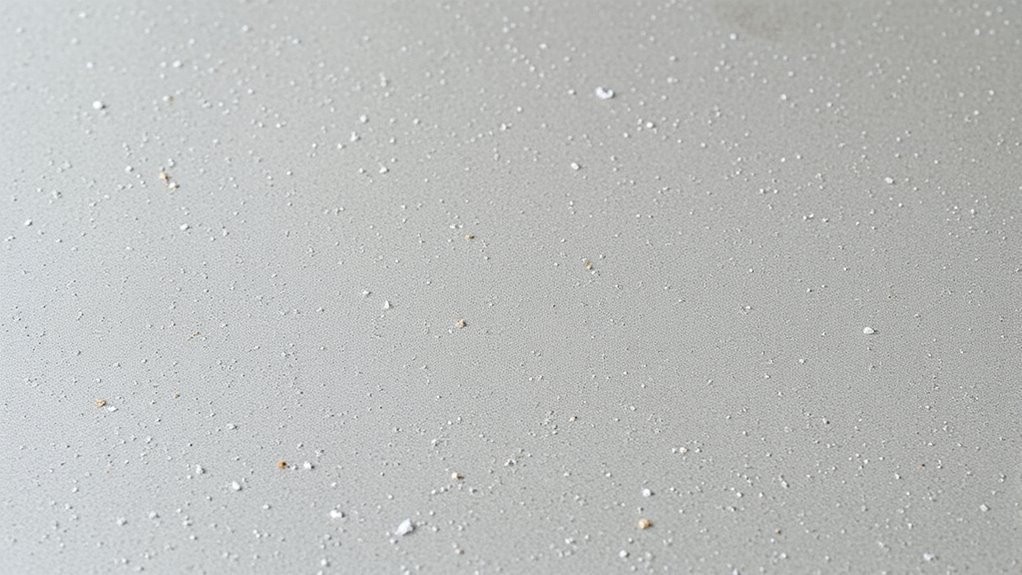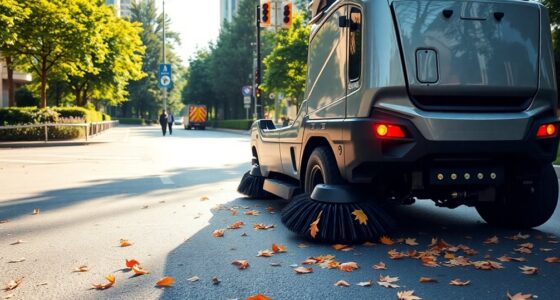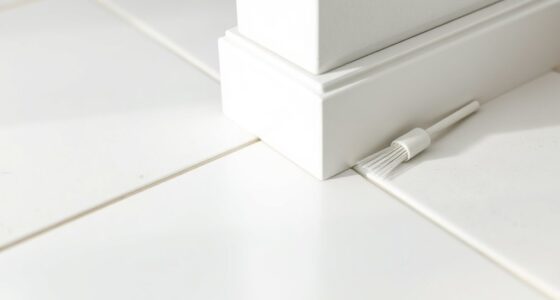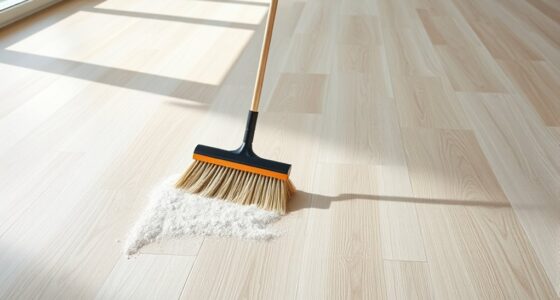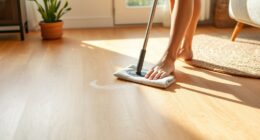To keep your concrete floors scratch-free during winter, sweep regularly with a soft-bristled broom or use a leaf blower to remove loose sand and salt. Wash the surface periodically with water and mild detergent to clear away residue that can cause erosion and scratches over time. Applying a sealant can also offer extra protection against damage. Consistent cleaning habits help maintain a durable, smooth surface—keep going to discover more effective tips.
Key Takeaways
- Use a soft-bristled push broom or leaf blower to gently remove loose sand and salt without scratching the surface.
- Regularly sweep to prevent abrasive buildup that can cause surface damage over time.
- Avoid metal shovels or stiff brushes that can scratch or damage the concrete during cleaning.
- Wash the surface periodically with water and mild detergent to eliminate residual salt and mineral deposits.
- Apply a concrete sealant to create a protective barrier against salt, sand, and moisture, preserving surface integrity.
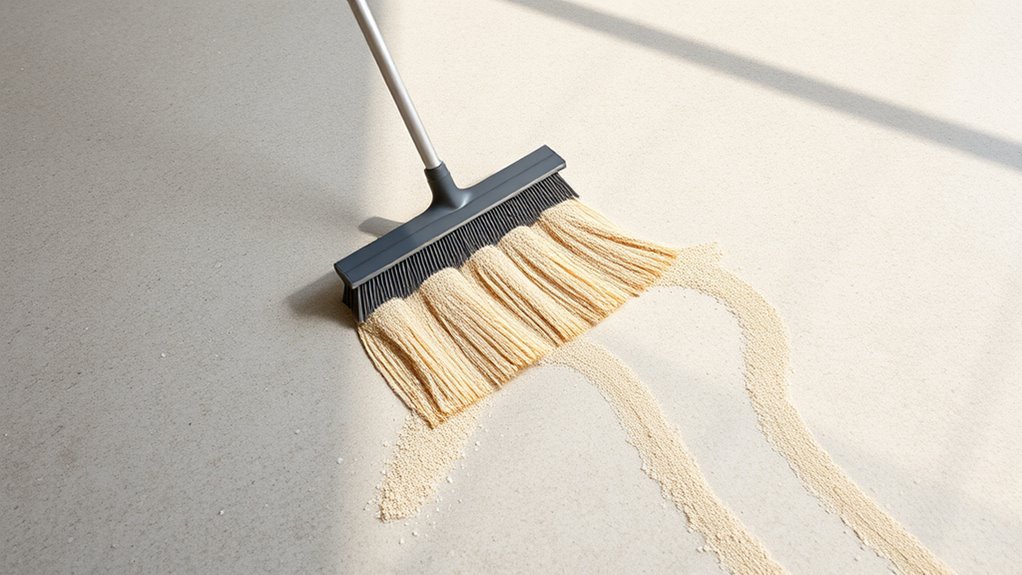
Have you ever wondered how sand and salt affect concrete floors during winter? These materials are commonly used for de-icing, but they can also cause lasting damage if not managed properly. Knowing how to handle them can extend the lifespan of your concrete surface and keep it looking its best. When it comes to de-icing methods, many people reach for salt because it’s inexpensive and effective at melting ice quickly. However, salt can be harsh on concrete, leading to surface erosion and scaling over time. Sand, on the other hand, provides traction without chemical damage but can become embedded in the surface, making it harder to clean and potentially causing scratches if not removed correctly. To maintain your concrete surface during winter, you need a proper cleaning routine that includes effective sweeping. This routine is essential because accumulated sand and salt can be abrasive, wearing down the concrete’s finish and creating tiny cracks that worsen with freeze-thaw cycles.
Your first step should be consistent sweeping to prevent the buildup of abrasive particles. Use a soft-bristled push broom or a leaf blower to remove loose debris and prevent it from grinding into the surface. Avoid using metal shovels or stiff-bristled brushes, which can scratch or chip the concrete. Once you’ve cleared away the loose material, it’s important to wash the surface periodically with water to remove residual salt and sand that might have become embedded. This helps reduce chemical buildup, which accelerates deterioration. During the cleaning process, consider using a mild detergent or specialized concrete cleaner, especially if you notice stubborn stains or mineral deposits from salt. Additionally, applying a sealant can further protect your surface from future damage by creating a barrier that prevents salt and moisture penetration. Remember that proper concrete surface maintenance isn’t a one-time task; it’s an ongoing routine that involves regular sweeping and washing, especially after storms or heavy snowfall. This proactive approach keeps your surface smooth and scratch-free, saving you money on repairs and preserving its appearance year-round. Ultimately, understanding de-icing methods and maintaining a consistent cleaning routine ensures that your concrete floors stay durable and attractive throughout the winter months, even with frequent exposure to sand and salt.
Frequently Asked Questions
Can Sand and Salt Damage Sealed Concrete Floors?
Yes, sand and salt can damage sealed concrete floors. When salt mixes with moisture, it causes chemical reactions that can weaken the sealant over time. Additionally, the surface porosity of concrete allows particles like sand to embed and create scratches during sweeping. To protect your floor, regularly remove these particles gently, and avoid harsh chemicals that might accelerate surface deterioration. Proper maintenance keeps your sealed concrete looking its best.
How Often Should I Sweep to Prevent Scratches?
You should sweep your concrete floors daily during winter to prevent scratches caused by debris like sand and salt. Regular floor maintenance helps you remove loose dirt and abrasive particles before they cause damage. Use a soft-bristle broom or a dust mop to efficiently clear debris, ensuring your floors stay protected and scratch-free. Consistent sweeping minimizes potential scratches and keeps your concrete looking clean and well-maintained year-round.
Are There Eco-Friendly Alternatives to Salt and Sand?
Did you know that over 80% of winter deicing products contain harmful chemicals? You can switch to environmentally friendly deicers like calcium magnesium acetate or natural sand substitutes such as cork or wood chips, which don’t damage your concrete or harm the environment. These eco-friendly options are just as effective in providing traction, helping you keep your floors safe without compromising sustainability.
What Tools Are Best for Removing Sand and Salt?
You should use a sturdy push broom with soft bristles or a leaf blower to remove sand and salt effectively. For eco-friendly alternatives, consider biodegradable sidewalk deicers like calcium magnesium acetate or sand alternatives such as kitty litter or wood shavings. These tools and products help keep your concrete floors scratch-free while minimizing environmental impact, ensuring a safe and eco-conscious approach to winter maintenance.
Does the Type of Salt Affect Concrete Surface Safety?
Think of salt type as a silent guardian of your concrete. Using calcium chloride might seem aggressive, but it’s gentler on your surface, ensuring concrete safety. On the other hand, rock salt can be rougher, risking tiny scratches over time. So, choose your salt wisely; it’s like selecting a gentle protector for your floor’s longevity. Your careful choice keeps your concrete sturdy and pristine.
Conclusion
By following a regular, scratch-free sweeping routine, you can keep your concrete floors looking pristine even during winter. Imagine a homeowner who notices less grit scratching her surface after just a few weeks of consistent cleaning. With each sweep, salt and sand are effectively removed, preventing damage and maintaining your floor’s beauty. Stick to this simple routine, and your concrete will stay smooth and clean for years to come.
